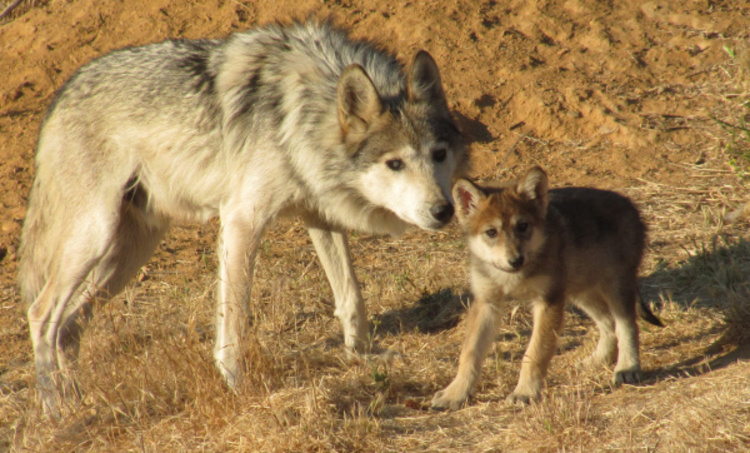Study: perhaps the domestication of modern wolves

The domestication of animals - a mutual relationship with people who have an impact on their care and reproduction. Charles Darwin at one time identified a number of signs by which domesticated species can be distinguished from their wild ancestors. He was also the first to find the difference between conscious selection, when people purposefully tamed specific animals, and unconscious selection, where the characteristics inherent in domestic animals develop as a by-product of natural selection.
The peaceful coexistence of the wolf and man began about 32 thousand years ago, and it was this species of animals that was the first to be domesticated. The wolf helped the ancient people to hunt, and later guarded their homes. The first data on the coexistence of a wolf and a man were found in the French cave Chauvet, and later this fact was confirmed by excavations in Ukraine, Russia, Belgium and the Czech Republic.
')
This happened thousands of years ago and can happen again: wolves in different parts of the world are gradually taking the path of becoming dogs. This is the conclusion reached by researchers who found that animals are increasingly attacking cattle and digging in the garbage left by humans instead of hunting in the wild. Such proximity to a person and his home over time can lead to conflict between humans and wolves, which may lead to disastrous consequences for both.
The study also explains how diet can change a large predator. To find out how gray wolves can suffer from eating large amounts of human food, evolutionary biologist from the University of Deakin in Melbourne Thomas Newsome and his colleagues investigated what happened to other large predators that live near humans.
For example, Asiatic lions in the protected area of the Gere of West India kill and eat only livestock, and therefore have become so less aggressive towards people that tourists can visit them without fear. In Israel, red foxes live longer and do not spread over long distances when they feed on waste. In contrast, black bears in North America who eat human garbage are more likely to die young because people kill them.
A 2014 study by Newsom about the dingo population in the Tanami Desert in Australia showed that the wild dog's habit of eating unhealthy food at a waste management facility made them too fat and less aggressive. They also became more prone to mating with local dogs and became “impudent”. Newsom says dogs dare to run between his legs when he sets traps for them.
Most interestingly, the “junk” dingo population has formed a genetic cluster different from all other dingos, which indicates that they are becoming genetically isolated. This, in turn, is a key step in the formation of a new species.
Is this what is happening now with gray wolves? Conditions are created for this, says Newsom, noting that human products already make up 32% of the diet of the gray wolf worldwide. Currently, animals live mainly in remote areas of Eurasia and North America, but some of them return to developed residential areas.
Wolves in Greece mainly consume pigs, goats and sheep. Those in Spain feed mainly on ponies and other livestock. Iranian wolves rarely eat anything other than chickens, domestic goats, and litter. “Based on what happened to these carnivores [that eat human foods], we think gray wolves will change,” says Newsom.
The new diet of wolves can affect everything: from the size of their packs to social behavior, according to a team of scientists. Like the dingo, these wolves are likely to mate with a large number of dogs, and in North America with coyotes, the researchers said.
Newsom expects that they will also begin to gradually move away genetically from wolf-hunters, just as it happened with the "garbage" dingo. Since it is believed that the ancient wolves evolved into dogs, using food and garbage in human camps, we can see today the "makings of a new dog", hypothesizes Newsom, who plans to start testing his ideas with wolves in Washington state.
Not all scientists share the position of Newsom. “I doubt that we domesticate wolves who eat the waste left by humans,” says Robert Wayne, an evolutionary biologist and dog genetics expert at the University of California at Los Angeles . - "It is more likely that this diet kills them."
Unlike the garbage dingos, which have reduced their territory, wolves are still so widespread that scavenger wolves are less likely to be genetically isolated from the rest of the population, he says. Lynxes, coyotes, and other animals that are already well integrated into the human environment are more likely to become domesticated, he adds.
Wayne and Newsom agree that for all these species the best result is not the domestication, but the restoration of their habitats and natural production in places where they can avoid people, livestock and litter. Newsom says that if people are satisfied, we will not have a new dog. But we still have wolves.
Scientific work published in the journal Science
DOI: 10.1126 / science.aal1007
Source: https://habr.com/ru/post/403013/
All Articles